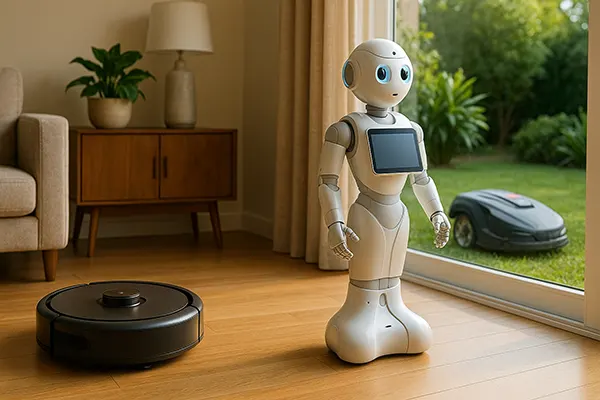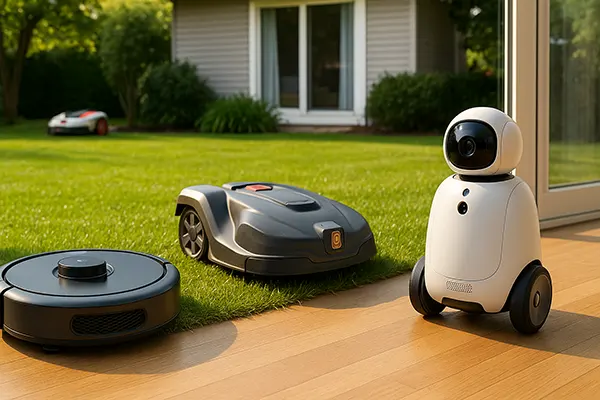In 2025, smart robots have transformed from luxury gadgets into indispensable household assistants. With AI-powered automation, these devices offer increased convenience, energy efficiency, and safety. From indoor cleaning to outdoor maintenance, robotic solutions are reshaping how people manage their homes.
Intelligent Cleaning: Evolution of Home Vacuum Robots
Robot vacuum cleaners have reached new heights in 2025. Unlike earlier models limited to random movements and basic dirt detection, today’s devices rely on advanced LiDAR, obstacle recognition, and real-time route planning. They clean efficiently, avoiding fragile items and adjusting suction power based on surface type.
Modern models like the Roborock S8 Max and iRobot Roomba Combo J9+ now integrate mopping functions, self-emptying docks, and even AI-driven voice assistant synchronisation. These devices can identify zones that require deeper cleaning, such as entryways or pet feeding areas.
Another innovation includes customisable user settings via smartphone apps, allowing scheduling, no-go zones, and maintenance reminders. Cleaning no longer demands supervision—it’s an automated and intelligent routine.
Challenges in Urban Living and Small Spaces
Despite technological advancements, small apartments and cluttered environments pose challenges for robotic vacuums. Manufacturers are addressing these with more compact designs and flexible navigation systems. Some robots now come equipped with telescopic sensors and enhanced edge detection for tight corners.
Battery life also remains a point of consideration, especially for multi-floor homes. However, improved fast-charging stations and larger battery capacities allow a full house cleaning in a single cycle for many users.
Moreover, compatibility with other smart home systems, including thermostats and air purifiers, helps provide an integrated living experience. This holistic automation helps reduce energy consumption while enhancing hygiene.
Outdoor Help: Robotic Lawn Mowers and Garden Assistants
In 2025, robotic lawn mowers have evolved into sophisticated machines capable of managing complex terrains and adapting to weather conditions. Devices like Husqvarna Automower NERA and Worx Landroid Vision feature GPS navigation, real-time obstacle avoidance, and adaptive mowing patterns.
Most robotic mowers now support voice commands, app controls, and geofencing. This means homeowners can programme the machine to avoid sensitive flower beds or restrict operation to specific times of day to comply with noise regulations.
Water-resistant and solar-powered variants offer better sustainability. Integration with weather sensors enables mowers to delay activity during rain or storms, thereby avoiding lawn damage and improving device longevity.
Integration with Smart Irrigation and Soil Monitoring
Many robotic mowers can now connect with smart irrigation systems. This connection ensures the mower avoids areas that have just been watered, preserving both grass health and battery efficiency.
Furthermore, some advanced models incorporate soil moisture sensors and fertilisation tracking. These tools assist homeowners in optimising lawn care schedules without requiring manual inspections.
As part of an interconnected ecosystem, these robots provide data that can be used to adjust watering, planting, and fertilisation strategies, ensuring healthier and more sustainable gardens year-round.

Security and Surveillance Robots for Modern Homes
Home security in 2025 is no longer limited to static cameras and motion sensors. Robotic surveillance units like Ring Always Home Cam and Moorebot Scout offer mobile patrols, facial recognition, and two-way communication, enabling dynamic protection and real-time alerts.
These robots can patrol predefined routes, investigate sounds or unusual movements, and stream live footage directly to smartphones. Some also feature built-in smoke and gas detection, adding another layer of safety to homes with elderly or vulnerable residents.
Privacy concerns are being addressed with features like local data processing, encrypted communications, and user-defined activity limits. This balance between autonomy and privacy is essential for mainstream acceptance.
AI Decision-Making and Emergency Responses
Security robots now leverage machine learning to distinguish between everyday activity and potential threats. For example, they can ignore a family pet but alert the homeowner about a broken window or forced entry.
Some models are programmed to call emergency services, activate sirens, or lock smart doors in response to specific security events. This proactive approach dramatically reduces response times during crises.
Additionally, these systems are becoming affordable for middle-class households, making intelligent home security accessible beyond luxury markets.

